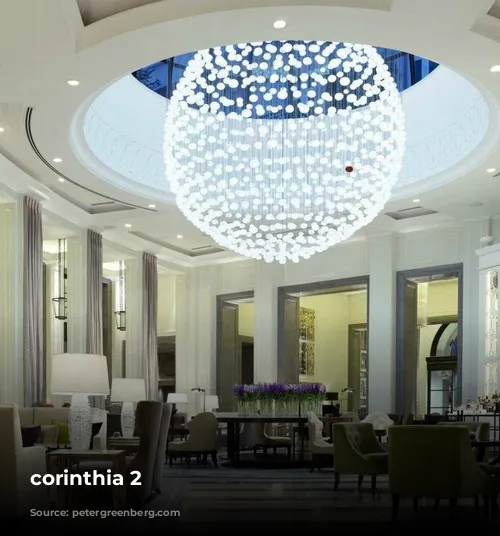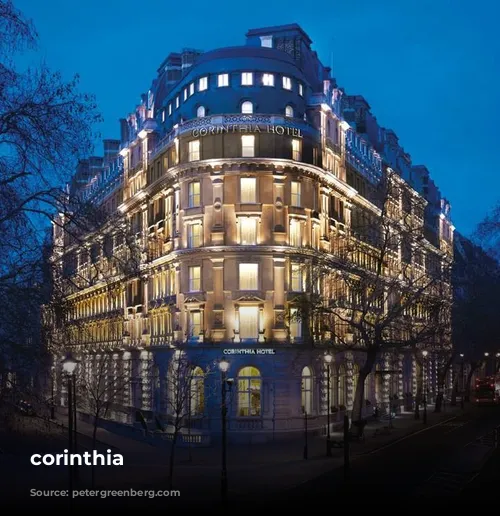The Corinthia Hotel in London, a luxurious haven today, stands as a testament to a rich and fascinating past. While it may appear as a brand new establishment, the building itself holds a century-old story—a story of grandeur, wartime service, and eventual rebirth.
This elegant structure once housed the bustling offices of the British government during the First World War. In the ensuing years, it played a vital role in World War II, becoming a headquarters for the secretive spy agency, complete with hidden underground passages connecting it to other vital government buildings. After the war, the grand building fell silent, left vacant for decades.

A $490 Million Transformation: From Government Offices to Luxurious Hotel
But its journey did not end there. In 2008, the Corinthia Hotel Group, recognizing the building’s remarkable history and prime location, took on the colossal task of revitalizing it. The $490 million restoration project—one of the largest in London—was a labor of love, ensuring the preservation of the building’s historical charm while injecting contemporary luxury.
The story of the Corinthia is intertwined with the remarkable Hotel Metropole, a 19th-century masterpiece that once occupied the same space. In 1885, the Hotel Metropole, a towering seven-story structure with over 600 rooms, opened its doors under the reign of Queen Victoria. It was a true marvel of its time, embodying the burgeoning concept of the “super-hotel” that was taking the world by storm.

A Visionary Architect: Frederick Gordon and the Rise of Modern Hotels
This grand hotel was the brainchild of Frederick Gordon, a visionary who is often hailed as the “father of the modern hotel industry.” Gordon’s vision extended beyond mere accommodation—he envisioned a world of unparalleled luxury and convenience. The Metropole, his third hotel, introduced groundbreaking amenities, including private bathrooms, telephones, and elevators—innovations that were unheard of in the era. Gordon understood the growing desire for comfort and luxury amongst travelers from France and the United States, and he aimed to cater to that demand.
The Metropole, a masterpiece of French architecture, reflected the architectural trends of the Haussmann era. Its grandeur made it a social hub for the elite, attracting celebrities and royalty like Edward VII and Buffalo Bill Cody. It was a place where London’s high society gathered, celebrating, and socializing.

From Luxury to Wartime Service: The Hotel’s Transformation
However, the hotel’s destiny took an unexpected turn during World War I. Its strategic location in the heart of London’s power center led to its conversion into government offices. The grand halls and opulent suites were replaced with desks and war strategies, and the hotel became a hub for the war effort.
One of the most notable figures to occupy the building was Winston Churchill, who worked in the offices before assuming his role as Prime Minister. He wrote about his experience witnessing the jubilant scenes of Londoners celebrating the end of the war, the joyous sounds mingling with the familiar chime of Big Ben.

A Silent Sentinel: The Building’s Role in World War II
The hotel building’s wartime service did not end with the First World War. During the Second World War, it played a pivotal role in the war effort once more, becoming a crucial base for the British secret service. The building’s clandestine activities included monitoring German internment camps and aiding troops in escaping capture.
The hotel, with its maze of hidden tunnels and passages, served as a link between the government offices. While these hidden pathways remain locked and secret, they whisper tales of wartime intrigue. These secret pathways symbolize the building’s role in wartime intelligence, adding another layer of intrigue to its history.

A Legacy of History and Transformation
After the war, the building continued to serve as a government office, eventually housing the Ministry of Defense. In the years following, the building witnessed a myriad of activities, including a dedicated UFO monitoring office until 2006. With time, the building fell into disrepair, eventually being put up for sale.
And then came the Corinthia Hotel Group, breathing new life into this historical gem. They took on the monumental task of restoring the building to its former glory while infusing it with modern luxury. This meticulous restoration project involved preserving the original elements, such as the exquisite ceiling in the Grand Ballroom, and meticulously blending them with modern amenities.
The Corinthia Hotel London stands today as a testament to its rich history, showcasing a captivating fusion of Victorian elegance and contemporary luxury. The grandeur of the past is reflected in its architectural details, while the modern amenities cater to today’s discerning travelers. With its 300 revamped guest rooms, including 47 suites, the hotel offers a truly immersive experience in the heart of London, providing a glimpse into a fascinating past while embracing the comforts of the present.









